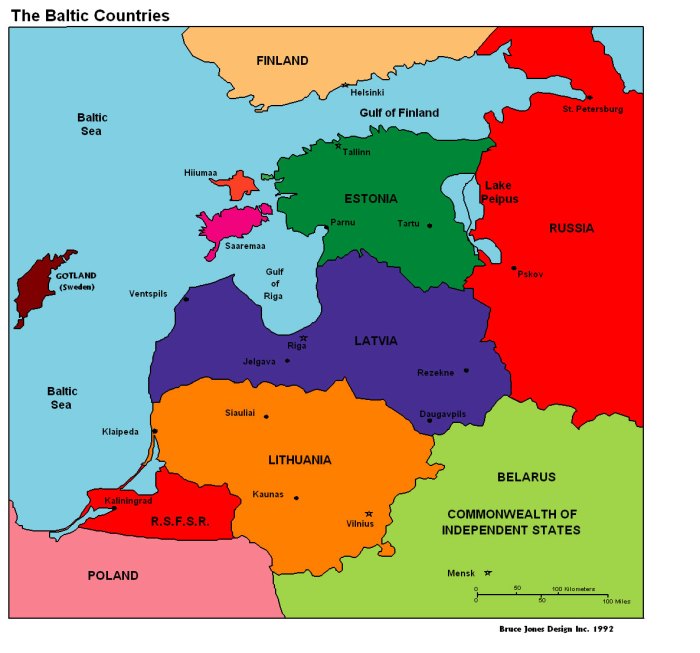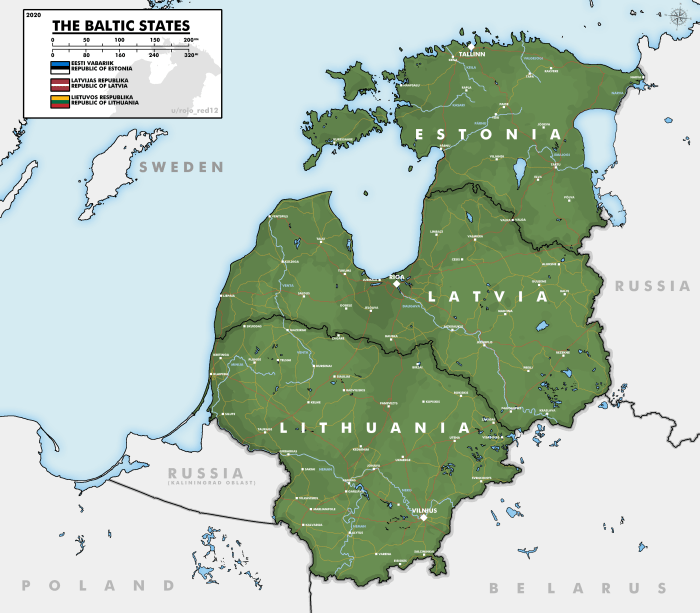The Baltic states—Estonia, Latvia, and Lithuania—have a rich and fascinating history, occupying a strategic geopolitical position at the crossroads of Northern and Eastern Europe. Their unique cultural heritage and recent economic development make them an intriguing subject of study.
From their historical significance as part of the Hanseatic League to their current membership in the European Union and NATO, the Baltic states have played a vital role in shaping the region’s destiny.
Historical Overview

The Baltic states of Estonia, Latvia, and Lithuania have a rich and complex history that has shaped their present-day identities. Located on the eastern coast of the Baltic Sea, these countries have been crossroads of trade and cultural exchange for centuries.
Throughout history, the Baltic states have been ruled by various empires, including the Swedish, Polish-Lithuanian Commonwealth, Russian Empire, and the Soviet Union. Each of these empires has left its mark on the region, influencing its culture, language, and political institutions.
Key Events in the History of the Baltic States
– 12th-13th centuries: The Baltic states are conquered by the Teutonic Knights and the Livonian Order.
– 1561: Estonia becomes a province of Sweden.
– 16th-18th centuries: The Polish-Lithuanian Commonwealth controls most of the Baltic states.
– 1721: Estonia, Livonia, and Ingria are ceded to Russia by Sweden.
– 1795: Lithuania is annexed by Russia.
– 1918: The Baltic states declare independence following the collapse of the Russian Empire.
– 1940: The Baltic states are occupied by the Soviet Union.
– 1991: The Baltic states regain independence following the collapse of the Soviet Union.
Political Landscape

The Baltic states of Estonia, Latvia, and Lithuania have established stable democratic political systems since regaining independence in 1991. They share common features such as parliamentary republics, multi-party systems, and a commitment to human rights and the rule of law.
The Baltic states have close relationships with their neighbors, particularly within the European Union (EU) and NATO. They cooperate on various issues, including economic development, security, and energy. The Baltic states also maintain strong ties with the Nordic countries and the United States.
Role in International Organizations
The Baltic states are active members of several international organizations, including the United Nations, the EU, and NATO. They have played a significant role in promoting regional cooperation and stability.
- European Union: The Baltic states joined the EU in 2004 and have been active participants in the organization. They have contributed to EU policies and initiatives, particularly in the areas of economic integration, security, and human rights.
- NATO: The Baltic states joined NATO in 2004 and have been strong supporters of the alliance. They have participated in NATO missions and operations, including in Afghanistan and Kosovo.
- United Nations: The Baltic states are active members of the United Nations and have participated in various peacekeeping and humanitarian missions. They have also been vocal advocates for human rights and international cooperation.
Economic Development
The Baltic states have experienced significant economic growth since regaining independence in 1991. All three countries have transitioned from centrally planned economies to market economies and have implemented comprehensive economic reforms. As a result, the Baltic states have become some of the most prosperous countries in Eastern Europe.
Economic Performance
The economic performance of the Baltic states has varied over the past three decades. Estonia has been the most successful of the three countries, with a GDP per capita of over $25,000. Latvia and Lithuania have also experienced strong economic growth, but their GDP per capita is still below that of Estonia.
There are a number of factors that have contributed to the economic success of the Baltic states. These include:
* A highly skilled workforce
* A favorable investment climate
* A strong commitment to free trade
* A sound financial system
Challenges and Opportunities
The Baltic states face a number of challenges in the global economy. These include:
* Competition from low-wage countries
* The need to diversify their economies
* The need to improve their infrastructure
* The need to address the issue of climate change
Despite these challenges, the Baltic states have a number of opportunities for economic growth. These include:
* Their strategic location on the Baltic Sea
* Their membership in the European Union
* Their access to EU funding
* Their strong human capital
The Baltic states are well-positioned to continue their economic growth in the coming years. By addressing the challenges they face and seizing the opportunities available to them, they can become even more prosperous and successful.
Cultural Heritage: Baltic States
The Baltic states of Estonia, Latvia, and Lithuania boast a rich cultural heritage that has been shaped by centuries of history and diverse influences. From unique languages and traditions to vibrant arts and crafts, the Baltic region offers a tapestry of cultural experiences that have captivated the world.
The Baltic languages, Estonian, Latvian, and Lithuanian, are distinct from other Indo-European languages and belong to the Baltic branch. They have preserved ancient features and are considered living relics of a prehistoric language group. The Baltic languages are a testament to the region’s unique linguistic heritage.
Traditional Customs and Folklore
Traditional customs and folklore play a significant role in Baltic culture. Folk songs, known as dainas in Lithuania and Latvia, and regilaulud in Estonia, are a prominent feature of Baltic folklore. These songs often depict rural life, love, and nature, and have been passed down through generations.
Other traditional customs include the celebration of Midsummer’s Eve, a pagan festival that marks the summer solstice. During this festival, bonfires are lit, traditional songs are sung, and people engage in folk dancing.
The Baltic states are known for their rich history, stunning architecture, and breathtaking natural beauty. However, if you’re looking for a fun and educational day trip, consider visiting the Audubon Zoo in New Orleans. This world-renowned zoo is home to over 500 species of animals from around the globe, making it a perfect destination for animal lovers of all ages.
After exploring the zoo, you can continue your journey through the Baltic states, discovering their many hidden gems.
Arts and Crafts
The Baltic states have a long tradition of arts and crafts, including textiles, ceramics, and woodworking. Estonian knitwear, Latvian amber jewelry, and Lithuanian linen are renowned for their beauty and craftsmanship.
Baltic architecture is also distinctive, with medieval castles, Gothic churches, and Art Nouveau buildings dotting the region. The Old Town of Tallinn in Estonia, the Riga Central Market in Latvia, and the Hill of Crosses in Lithuania are just a few examples of the region’s architectural heritage.
The Baltics are a region of Northern Europe that is known for its stunning natural beauty and rich history. While there are many places to visit in the Baltics, some of the most popular include the medieval city of Tallinn, the charming town of Riga, and the beautiful beaches of Lithuania.
If you are looking for a more in-depth look at the best places to visit in the USA, be sure to check out our guide best places to visit in usa. From the bustling cities of New York and Los Angeles to the stunning national parks of Yosemite and Yellowstone, the USA has something to offer everyone.
Once you have explored the best places to visit in the USA, be sure to come back and visit the Baltics for a truly unique travel experience.
Influence on the Wider World
Baltic culture has had a significant influence on the wider world. Baltic composers such as Arvo Pärt and Pēteris Vasks have gained international acclaim for their minimalist and evocative music.
Baltic literature has also made its mark, with authors such as Jaan Kross, Vizma Belševica, and Jurga Ivanauskaitė translating their works into multiple languages. The Baltic states have also produced notable filmmakers, artists, and designers, who have contributed to the global cultural landscape.
Regional Cooperation
Regional cooperation among the Baltic states is crucial for their economic, political, and security interests. It enhances their collective voice on the international stage, promotes economic integration, and strengthens their defense capabilities.
The Baltic states have established several mechanisms for cooperation, including the Baltic Assembly, the Baltic Council of Ministers, and the Baltic Sea States Subregional Cooperation (BSSSC). These platforms facilitate dialogue, policy coordination, and joint initiatives.
Challenges and Opportunities
Despite the progress made, regional integration faces challenges such as differing economic development levels, historical tensions, and external influences. However, there are also opportunities for further cooperation, such as in areas of energy, infrastructure, and digitalization.
Security Issues

The Baltic states, comprising Estonia, Latvia, and Lithuania, have faced several security concerns in recent years. Their proximity to Russia, coupled with historical tensions and geopolitical dynamics, has influenced their security landscape.
The region has witnessed increased military activity, cyberattacks, and disinformation campaigns, raising concerns about the potential for hybrid warfare tactics.
NATO and EU Involvement
NATO and the EU play crucial roles in ensuring the security of the Baltic states. NATO’s presence in the region, through its enhanced Forward Presence (eFP) and Baltic Air Policing mission, serves as a deterrent against potential aggression.
The Baltic states, Estonia, Latvia, and Lithuania, are a fascinating region with a rich history and culture. If you’re looking for a seaside getaway, consider visiting Barry Island , a popular destination in Wales known for its beautiful beaches, amusement park, and Victorian promenade.
After exploring Barry Island, you can continue your journey through the Baltics, discovering the charming cities of Tallinn, Riga, and Vilnius.
The EU’s Common Security and Defence Policy (CSDP) also contributes to regional stability through cooperative initiatives, such as the European Defence Agency (EDA) and the European Union Force (EUFOR).
Potential Threats
Potential threats to the security of the Baltic states include:
- Russian military activity: Russia’s annexation of Crimea and support for separatists in eastern Ukraine have raised concerns about its intentions towards the Baltic states.
- Cyberattacks: The Baltic states have been targets of cyberattacks, including those attributed to Russia. These attacks can disrupt critical infrastructure and undermine public trust.
- Disinformation campaigns: Russia has been accused of spreading disinformation to influence public opinion and sow discord within the Baltic states.
Summary

The Baltic states continue to navigate the challenges and opportunities of the 21st century, balancing their desire for regional cooperation with the need to maintain their distinct national identities. Their future holds the promise of further economic growth, cultural exchange, and a secure place within the European community.
FAQ Resource
What is the significance of the Baltic states?
The Baltic states have historically been a crossroads of trade and culture, connecting Northern and Eastern Europe. Their strategic location has made them a focal point of geopolitical competition.
What are the key challenges facing the Baltic states?
The Baltic states face challenges related to economic development, regional cooperation, and security. They must balance their desire for economic growth with the need to preserve their cultural heritage and maintain their independence.
What is the future of the Baltic states?
The future of the Baltic states is promising. They are members of the European Union and NATO, and they have strong economic ties to the rest of Europe. They are also working to strengthen regional cooperation and address the challenges they face.